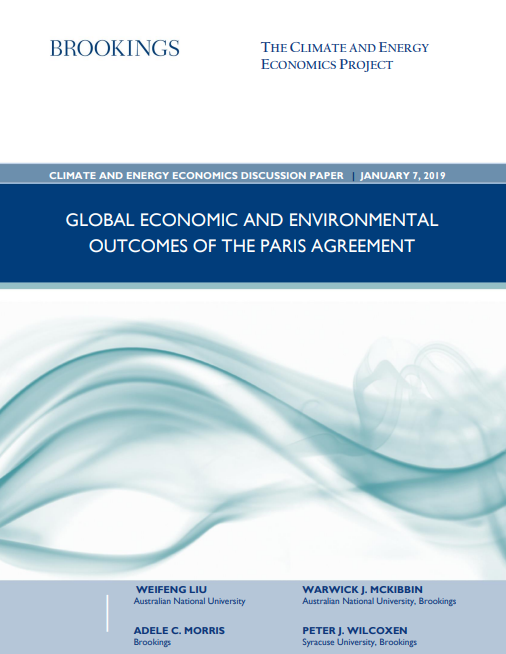This report analyzes the economic and environmental impacts of the Paris Agreement. This agreement aims to stabilize greenhouse gas (GHG) concentrations to prevent dangerous climate change. A multi-region world economy model projects potential outcomes if countries fulfil their Nationally Determined Contributions (NDCs) as promised. Global economic and environmental outcomes of the Paris Agreement
The findings suggest that the Paris Agreement significantly reduces CO2 emissions compared to the baseline if all regions achieve their NDCs. However, under the Paris policy scenario, global CO2 emissions would not decrease in absolute terms compared to 2015.
Also, reductions in CO2 emissions do not necessarily correlate with the CO2 tax rate. Furthermore, it explores the macroeconomic spillovers across the global economy. Countries heavily relying on fossil fuels for domestic energy and exports see the most significant GDP declines relative to the baseline.
Key Findings on Global Economic Outcomes
- The study highlights that the targets set in the Nationally Determined Contributions (NDCs) of the Paris Agreement have significant implications for global economic outcomes and individual regions.
- The differential targets across regions result in varying impacts, including emissions taxes required and effects on GDP and welfare.
- The co-benefits from reductions in conventional pollutants are substantial, leading to net benefits for every region participating in the agreement.
- The two largest CO2 emitters, China and the United States are better off participating in the agreement than withdrawing from it, with participation yielding larger economic benefits.
- The global climate benefit of the Paris Agreement through 2030 is estimated to be $2.25 trillion in present value, assuming a social value of $42 US per metric ton of CO2 abated.
Assessment of Environmental Impacts
- The authors consider the climate benefits produced by the Paris Agreement, noting that these benefits are significant even though the agreement does not stabilize emissions.
- The study accounts for the monetized climate and domestic co-benefits of emissions reductions. It shows that countries like the United States, China, and Australia would be worse off if they unilaterally withdrew from the agreement due to the net benefits generated by participation.
- The research evaluates the global climate benefits contributed by each participating region in the model through 2030, allowing for the calculation of net domestic benefits to each region.
Overview
1. Introduction
Sets the stage by providing an overview of the Paris Agreement and its significance in the global effort to combat climate change.
Global Climate Agreement
- The Paris Agreement, adopted in 2015 by the Parties to the United Nations Framework Convention on Climate Change (UNFCCC), is highlighted as a landmark global climate change agreement signed by 197 countries.
Objective
- The primary aim of the agreement is to stabilize greenhouse gas (GHG) emissions at a level that would prevent dangerous climate change. However, the commitments made in 2015 are acknowledged as insufficient to achieve this goal independently.
Entry into Force
- The agreement officially entered into force on November 4, 2016, following the participation of at least 55 Parties representing at least 55 per cent of global GHG emissions.
Global Significance
- The Paris Agreement is recognized as the first truly global climate change agreement, signifying a collective effort by nations to address the pressing issue of climate change worldwide.
Limitations of Commitments
- While the commitments made under the Paris Agreement are deemed inadequate to address the challenges of climate change fully, they represent a crucial step towards international cooperation and coordinated action.
Context Setting
- The introduction provides context for the study’s focus on analyzing the economic and environmental outcomes of the Paris Agreement, emphasizing the importance of understanding the implications of the NDCs put forth by countries.
Importance of Analysis
- The introduction underscores the significance of assessing the economic and environmental impacts of the Paris Agreement to evaluate the effectiveness of the NDCs and the potential benefits of global cooperation in combating climate change.
2. Representing NDCS In Modeling Scenarios
Discusses the challenges and methodologies in converting the Nationally Determined Contributions (NDCs) of different countries into a common framework for analysis within the modeling scenarios.
Variability of NDC Formulations
- The NDCs vary significantly across countries regarding the greenhouse gases covered, targeted sectors, base years, target achievement timelines, and metrics used for the targets.
Conversion for Comparison
- To analyze these diverse NDC targets, the study first converts them into a standardized framework for comparison across regions.
Aggregation for Modeling
- The NDC targets are aggregated where necessary to align with the geographic detail in the G-cubed model used in the study.
Methodology
- The approach taken in this study is compared to previous research, such as the work on commitments in the Copenhagen Accord, to ensure consistency and accuracy in modeling the NDCs.
Limitations
- One limitation highlighted is that the G-Cubed model only includes CO2 emissions from fossil energy combustion, not other greenhouse gases or CO2 from industrial processes, which may impact the analysis.
Complexity of Emissions Paths
- Converting NDC targets into model-relevant emissions paths involves estimating emissions levels for years before the target date and addressing different target expressions like emission intensities.
Geographic Detail
- The study outlines the regions included in the G-Cubed model, such as Australia, China, Europe, India, Japan, OPEC, Russia, the USA, and others, to facilitate the analysis of NDCs at a regional level.
3. Other Studies of the Paris Agreement
Provides an overview of the existing literature on modeling the Paris Agreement, focusing on studies that utilize large-scale computational models.
Scope of Literature
- Acknowledges the vast body of literature exploring the Paris Agreement, encompassing studies with diverse methodologies and approaches.
Methodological Focus
- Highlights studies that utilize large-scale computational models to analyze the implications of the Paris Agreement.
Temporal Context
- Studies range from those conducted before the Paris negotiations to inform NDC proposals to those undertaken post-agreement implementation.
Comparative Challenges
- The studies are not directly comparable due to the Paris Agreement’s variations in targets, policies, modeling approaches, assumptions, and focal points.
Modeling Strands
- Global studies on the Paris Agreement typically fall into three main strands, focusing on dynamic computable general equilibrium (CGE) models that emphasize macroeconomic aspects.
Specific Studies
- References early studies like McKibbin (2015a, 2015b) that used the G-Cubed model, similar to the approach adopted in the current paper, to assess the economic and environmental impacts of the Paris Agreement.
Research Focus
- Studies vary in their emphasis, ranging from comparing NDCs to 2°C warming targets to assessing the overall effectiveness and implications of the Paris Agreement.
Literature Overview
- Aims to provide a broad overview of the existing literature on modeling the Paris Agreement, highlighting the diversity of approaches and findings within this research domain.
4. Modeling Approach and Baseline Projections
Delves into the methodology employed in the study to analyze the economic and environmental implications of the Paris Agreement using the G-Cubed model.
Model Enhancements
- The G-Cubed model was extended to enhance its suitability for analyzing the Paris Agreement, with new country coverage for India and the Russian Federation and revised regional aggregation for Europe.
Sectoral Coverage
- Includes a detailed representation of the electricity sector, encompassing specific generation technologies such as coal, natural gas, oil, nuclear, wind, solar, hydro, and other renewables.
Baseline Scenario
- Outlines the baseline scenario, the business-as-usual (BAU) scenario, which assumes that regions maintain existing policies without implementing new measures to achieve their NDCs.
Projection Methodology
- The baseline projection involves modeling the economy’s evolution from 2015 to 2016, projecting labor force and productivity growth by sector and country from 2016 onwards.
Historical Dynamics
- The baseline scenario incorporates historical dynamics leading up to 2016 to provide a foundation for projecting future economic and environmental outcomes.
Comparative Analysis
- Compares its long-term projections with other global economic models to validate the baseline assumptions and projections.
References
- References previous works by McKibbin, Pearce, Stegman, and others to comprehensively understand the modeling approach and baseline projections used in the study.
5. Outcomes of the Paris Agreement
Presents the results of the policy scenarios analyzed using the G-Cubed model to assess the economic and environmental implications of the Paris Agreement.
Policy Scenarios
- Evaluates the outcomes of different policy scenarios, including one where all regions participate in the Paris Agreement and another where select countries withdraw from the agreement unilaterally and undertake no new climate policies.
Impact Analysis
- The scenarios consider the effects of meeting NDC commitments on global carbon dioxide emissions, GDP growth, trade, and investment flows in each region represented in the model.
Country Participation
- Includes scenarios with and without the participation of key countries like the United States, China, and Australia to assess the differential impacts of their involvement in the Paris Agreement.
Environmental Assessment
- Estimates the reduction in global carbon dioxide emissions achieved through implementing NDCs compared to a scenario without these policies.
Economic Evaluation
- The economic results of the policies are examined in terms of their impact on GDP growth, trade dynamics, and investment patterns across different regions.
Ambition Comparison
- The goal is to understand the absolute and relative environmental and economic ambition of countries’ pledges under the Paris Agreement.
Section Structure
- Outlines the NDCs of the regions in the model, provides an overview of other studies on the Paris Agreement, introduces the G-Cubed model, and presents the baseline scenario before delving into the policy scenario results.
Comprehensive Analysis
- By simulating various policy scenarios and assessing their outcomes, the study aims to provide insights into the effectiveness and implications of the Paris Agreement in addressing climate change while considering the economic consequences for different regions.
6. Conclusion
Summarizes the global economic and environmental implications of the Nationally Determined Contributions (NDCs) under the Paris Agreement.
Assessment of NDC Targets
- Acknowledges that while some scientists argue the NDC targets may not be sufficient to limit global warming to 2°C, they still have significant implications for global outcomes and individual regions.
Regional Disparities
- Differential targets across regions lead to varying impacts, whether in terms of required emissions taxes or effects on GDP and welfare.
Co-Benefits
- Reductions in conventional pollutants yield substantial co-benefits, such that every region benefits from participating in the agreement even without considering climate change reductions.
Country Participation
- China and the United States, the two largest CO2 emitters, are better off participating in the agreement than withdrawing, offering greater benefits than non-participation.
Climate Benefits
- Despite not stabilizing emissions, the Paris Agreement generates significant climate benefits. The global climate benefit through 2030 is estimated at $2.25 trillion in present value, assuming a social value of $42 per metric ton of CO2 abated.
Policy Implications
- Underscores the substantial climate benefits of the Paris Agreement and highlights the economic and environmental advantages of global participation in the accord.
Implications for China and the US
- The observation that both China and the United States benefit from participating in the agreement emphasizes the importance of international cooperation in addressing climate change.
Overall Impact
- Concludes by emphasizing the significant positive outcomes of the Paris Agreement, despite the challenges and criticisms regarding the adequacy of the NDC targets in achieving the 2°C warming goal.
Therefore. Nonetheless. However. Nevertheless. In conclusion. Henceforth. On the other hand. Hence. Furthermore. Therefore. Nonetheless. However. Nevertheless. In conclusion. Henceforth. On the other hand. Hence. Furthermore. Therefore. Nonetheless. However. Nevertheless. In conclusion. Henceforth. On the other hand. Hence. Furthermore.




